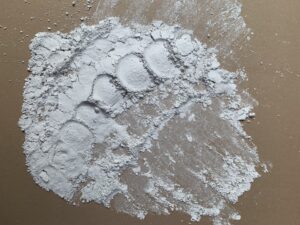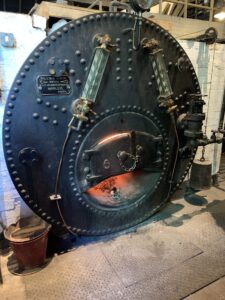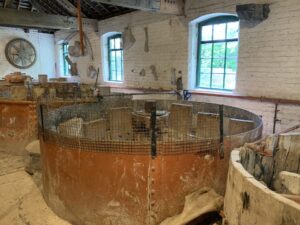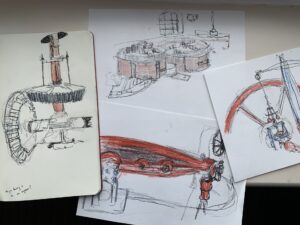Annie Lord looks back on a year in calcium.

The four most abundant elements in your body are oxygen, carbon, hydrogen and nitrogen. After this comes calcium. Calcium gives strength and structure to your skeleton. It provides you with a shape in which to exist on earth. As well as being a major component of our bones, calcium is found in the exoskeletons of crustaceans, in eggshells and pearls, marble, chalk and limestone. It is body, and land and home.
1: Egg
My phone buzzes: it is a friend. Could I look after her incubating duck eggs for a few days? I say yes and then begin to worry. I let myself into her house, and there they are on the dining table – four white eggs in a small plastic incubator. The eggs must be rotated 180 degrees, three times a day. This rotation mimics the way that the mother duck would shift the eggs beneath her brooding body, preventing the developing embryo from getting stuck to the membrane. I look up a video which tells me how to turn the eggs without needing to lift them from the safe warmth of the incubator. Their shells are porous, so I wash my hands with vigour – not wanting to transmit bacteria from skin, to shell, to duck. I feel clumsy turning the eggs. My hands are no replacement for webbed feet, and a feathered body.
The incubator lets out a constant low hum. I cannot stop thinking about the eggs, about what is happening under those calcium shells. I cannot be the one to fail them. I have work to do, but when I open my laptop, I close the document I’m working on and instead watch video after video of people discussing their tips on successful egg incubation.
My friend returns and I relinquish the eggs to her care. A few days later I receive a message – the first egg has hatched. The others follow suit – the eggs pecked open by rounded beaks and an occasional pair of helping human hands. By chance, I am there when the last duckling hatches. Released from the curvature of its shell it struggles to balance, the weight of its head tipping it forward. My friend folds her woollen hat and places it next to the duckling in the incubator, a soft landing for a new-born. It all feels impossible, and I can barely watch the bird straining to stand before it is ready. Just wait awhile, I think.
2: Cup
I have a cup which is too small for a satisfying amount of tea. But still, sometimes it is the vessel I pick. I choose it because the ceramic body is thin enough that when I lift it up to the light, I can see the outlines of my fingers through it. This semi-translucency highlights the colour of the tea itself. I pour boiling water onto the tea bag and the liquid turns a deep amber. I always pause, watching the steam spiral and twist. On the base of this cup are printed the words, ‘fine bone china’. For many years I read these words without giving them much thought. I did not stop to think that the bone in bone china was just that; the ground up skeletons of cattle. Even now that I know this, it’s hard to align the delicate cup in my hand with a once-living creature. Developed in the latter half of the 18th century, at first by Thomas Frye in Bow, East London, and later by Josiah Spode in Stoke-on-Trent, bone china is made from calcined bone ash, china stone and china clay. It is exceptionally strong, and it is this strength which allows the clay to be formed so thinly. The lip of a bone china cup is a delicate presence in the mouth.
3: The Bone Mill
From 1857 until 1972 Shirley’s Bone and Flint Mill in Stoke-on-Trent processed raw materials for use in the city’s world-famous pottery industry. Built beside the canal, it is now run by a group of volunteers. Several times a year they fire up the steam engine and invite the public to see the machinery in motion once again. Early in the year I contacted long-time volunteer Bernard Lovatt to ask about the mill. Now, in late July he greets me warmly at the door and introduces me to the many people who work to keep the site active. Today is the culmination of a busy week for the volunteers, they have spent five days feeding coal into the boiler to build up the intense heat required to power the engine. Bernard talks me through the history of the site, and the physical, grimy nature of the work. Today I’ll witness a cleaned up, reduced-scale presentation of an industrial process. He gestures down at his outfit, “We’ve got our clean overalls on today”.

Inside one of the old red brick buildings I meet a couple who last came here in the 1970s. She tells me how much it has changed, how the trees have grown up along the canal creating a peaceful green canopy. But what is most notable is the lack of bones. Back then, she tells me, they were piled in great heaps around the yard. She makes an arc with her arms to show me the scale of them. When the mill first opened, cattle bones were brought in from local slaughterhouses, by-products of the meat industry.
From the canal footpath, I descend a short flight of stairs into the gear room. Originally this room was at ground level, but as the canal path was raised to make up for mining subsidence, the lower section of the building was interred. Inside, the windows are bricked up to their midway point, and even on this bright day the room is dingy. The gears are hulking things, their metal teeth greased with thick black lubricant. I’m drawing them when a woman approaches and asks if I’m training to be an engineer. I tell her no, but that drawing is the best way for me to understand the machinery. She tells me that her daughter, now in her fifties, wanted to be an engineer but the local college steered her away from that path, telling her that only boys took that course. “She’s a physiotherapist now” she tells me, “An engineer of the body.”

The grinding room is directly above us. It is brighter, one side of the space punctuated with tall windows. The long sides of the room are lined with large circular grinding pans. I stare into one of them. It is a rugged thing, showing signs of decades of use. Its base is formed of stone, and a pole extends up through its centre from the gear room below. Metal arms with wooden panels are attached to the poles. When in motion they sweep large boulders around the base, grinding whatever is inside into smaller and smaller particles. Originally it would have been a mixture of either calcined bone or flint, along with water to make a slurry but today it’s only clay and water. When bones were used, they would have already been through several steps of refinement. Boiled to remove any remaining tissue and cartilage. Then heated to around 1000 degrees in a kiln. Bernard holds out a box filled with pieces of calcined bone. They are bright white, and leave a soft, dusty residue wherever they lay. In this state they are easy to crush into fine particles.
From the engine room next door, a bell rings three times, and the machinery judders into action. This quiet room fills with noise. The clanking of the metal gears from below, the clatter of wood on stone and the wet sucking noise of the clay as the paddles beat against it. A small group enters, and a volunteer turns to chat to them, raising his voice above the clamour. He tells them that not any old bone would have been used to make bone china. The shin bones of cattle were best. As I stand there sketching, trying to capture the corroded metal of the pans, I overhear the volunteer relating this fact to new groups of visitors. Only the shin bones will do. That night I dream of amputations. In sleep, I greet the missing limbs with mild indifference.

After
Up until now, I’ve thought very little about my bones. I’ve been fortunate enough to have never needed to. I’ve never broken a bone, never needed to be placed in a cast or surgically pinned back together. But all this talk of bones has seeped into me. A few days after my trip to the mill, I turn to my partner and ask her if she knows what to do with my body after I die. We’ve discussed it before, and she confirms that she won’t put my ashes in the sea. Too cold. Too dark. She asks if a beach would be ok. I tell her no. Put me in the earth. A forest, or a garden, or the compost heap. I am soothed by the idea of becoming soil. Sometimes when my physical body gets the better of me, I ask if she wouldn’t mind digging me a hole in the garden and placing me in for a while. I’ll keep my head above ground, I promise. She always says no.
*
Annie Lord is an artist and writer based in Edinburgh. In 2020 she was commissioned by Art Walk Projects to create The Neighbouring Orchard, an ongoing artwork creating a community of 160 apple trees across Edinburgh’s coastal suburbs. In 2022 she was shortlisted for the Quiet Man Dave Flash Non-Fiction award and in 2023 was shortlisted for the Nan Shepherd Prize. Visit her website here.